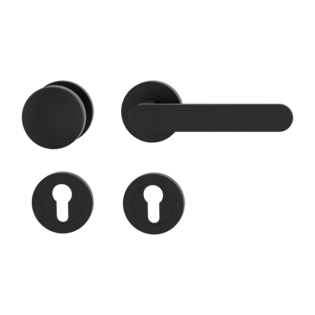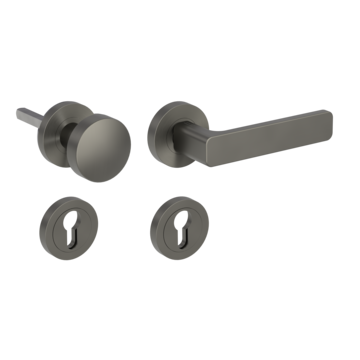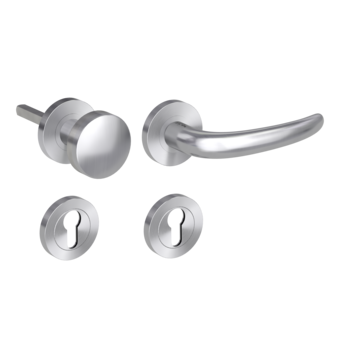All about door knobs
We use them every day, often without realizing it: door hardware opens our doors. In Germany, the Door handle is the most common door fitting. Internationally, however, the doorknob is more widespread. Find out here what special features it has and where it is also often used in Germany.
Door handle versus doorknob
In the Door handle, the handle is a lever that you push down. The mechanism inside the door pulls back the latch and the door opens. A great advantage of this is the ease of use: if you have both hands full, you can operate the Door handle with your elbow in an emergency. For this reason, Door handles are very often used on room doors . The disadvantage is security: even small children or pets quickly find out how a Door handle works - if you want to be sure that a door with a handle stays closed, you have to resort to a lock and key.
The Door knob - also called Door knob or Lever handle - on the other hand is a round door handle. To open the door, you have to turn it. Since this can only be done with a free hand and with a certain degree of fine motor skills, doors with a doorknob cannot be opened by small children or pets.

Doorknobs in Germany
In Germany, the door knob is rarely found on room doors, but mostly in the form of interchangeable sets or protective rosette sets with a fixed knob - usually made of stainless steel.
A knob handle door set consists of a door handle on the inside of the door and a door knob on the outside, which cannot be turned. Such a door can only be opened from the outside with a key and is therefore often used as a front door. In the case of the door knob of a changeable set, the lock can be housed under the knob in a separate rosette or, in the case of a long plate, in the door plate. However, the lock can also be integrated directly into the door knob.

A security rosette set also has a lever handle on the inside and a fixed door knob on the outside. The special feature of this lever handle set is an additional pull protection on the inside of the door and a burglar-proof stainless steel protective rosette on the outside under the door knob.

Other types of doorknobs
Since door knobs enjoy great popularity internationally, there are other types of door knobs with different functions:
A Lever handle set with one rotating knob on each side and Without lock case is in many countries the counterpart to the conventional Door handle for room doors that do not have to be lockable.
Lever handle sets are like a "little sister" of the Alternate set, with a rotating door knob with an integrated lock case on the outside. On the inside of the door it is complemented by a knob that also rotates, in the middle of which there is a knob. If the knob is not pressed, the set works just like the simple door knob set for room doors. If the knob is pressed, it can be opened from the inside by simply turning it, but from the outside only with a key. This variant is used mainly for side entrances of private houses, as well as in business premises and offices.
The same system is available without a lock case on the outside, i.e. the door can be opened only from the inside when the Knob is pressed. This is mainly used for bathrooms, WC and other rooms with desired privacy.
Door knob design
Regardless of function, doorknobs come in just about every design, style and material. For ergonomic reasons, most are round, but there are also cylindrical designs.
A hardware made of iron or brass with ornaments or antique patina fits wonderfully with Country style or very traditional interiors. A combination of Metal and Wood also goes well with this style - or to add a warm touch to a modern home.
Minimalist versions made of Aluminium, Chrome and Stainless steel are the all-rounders among door knobs. They are available polished or - now fully in vogue - matt brushed. This finish harmonizes particularly well with the Hygge style, but also with minimalist interiors. At Griffwerk, you can also get stylish and haptically pleasant versions in Black or Cashmere grey.
Plastic sets have the advantage of being very easy to clean and available in a great many colors. However, they are slightly less durable.
No matter what the purpose, door and style: beautiful door knobs are available for all.
The most frequently asked questions about door knobs
What questions are most often asked about doorknobs? We found out using software that analyses which questions people ask voice assistants from Apple, Google and the like. We answer three of them here:
What are the different types of door knobs?
There are different types of door knobs to suit different types of doors and styles. Some common types are ball knobs, lever handles, gear knobs and round handles. Ball knobs are classic and versatile, while lever handles offer easier operation. Shift handles are particularly suitable for doors with locks, and round handles are often used on modern doors. All the types mentioned can be combined with each other as interchangeable sets.
What materials are used for door knobs?
Doorknobs can be made of different materials, each with their own merits. The most common materials are metal alloys such as stainless steel, brass and zinc alloys. These are durable and offer a wide range of finishes, such as polished, brushed or antique. There are also door knobs made of wood, glass or plastic, which can be chosen depending on the desired style or application.
How to install a doorknob?
The exact installation of a Door knob can vary depending on the model, but generally follow the steps below:
- First, remove the old Door knob, if nn. This may require loosening screws and removing the escutcheons or covers.
- Align the new Door knob on the door and insert the mounting screws through the appropriate holes in the door.
- Tighten the screws to securely fasten the Door knob, but without overtightening them.
- If necessary, install the escutcheons or covers to conceal the screws.
- Test the Door knob to make sure it works properly and turns easily.






















































































